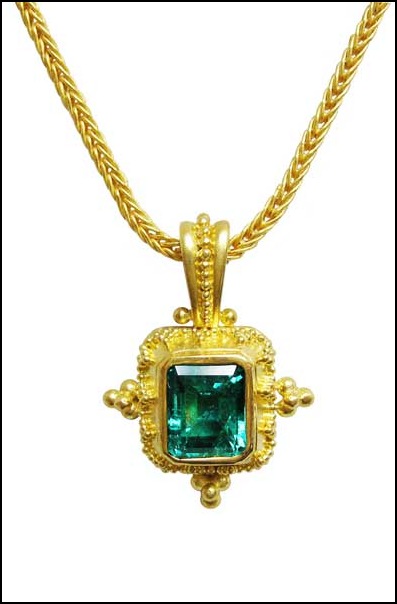Check out our Emerald board on Pinterest for more photos and info!

Julie Rauschenberger set this stunning emerald with her signature 22 karat gold granulation technique.
Emerald
Believed by the ancients to empower the owner with foresight into the future, emerald has been regarded as an amulet for good fortune, rebirth and the abundance of the life force. It is the birthstone for May and a talisman for Gemini, and is one of the most highly prized of all gems. Emerald was dedicated by the ancients to the goddess Aphrodite, and has been thought to be a symbol of immortality and faith.
Emerald is the green variety of Beryl, The rich green hue brings to mind the regeneration of life in spring and hope of new possibilities. Spring can also be seen in the network of inclusions in the depth of the emerald that the French call the “jardin”, or “garden”, because it resembles foliage. The inclusions are like a fingerprint, giving each emerald a distinct personality and distinguishing them as truly natural gemstones.
Emeralds can be cut in a variety of different shapes, ranging from the traditional rectangular step-cut, known as the "emerald cut," to rounds, ovals, squares and cabochons.
The ancient Egyptians mined emeralds nearly 4,000 years ago, and Cleopatra was an avid collector. Emeralds have been obtained from the schists of Cleopatra's mines, rediscovered in 1818, in the Sikait-Zubara region of Egypt. Vast quantities were taken from South America during the Spanish conquest, but the original mines have since been lost. Some of these stones are recently being recovered by diving efforts of shipwrecked Spanish Galleons.
Today, most of the world's emeralds are mined in Colombia, Brazil and Zambia. Colombian emeralds are generally the most prized due to their transparency and fire. Some of the most rare emeralds come from three main mining areas in Colombia: Muzo, Coscuez, and Chivor. In the US, emeralds can be found in Hiddenite, North Carolina. In 1998, emeralds were discovered in the Yukon.
----------
In addition to
the above information from the AGTA and other sources, you
can find facts about these of gems and more at the
"Gems
and Gem Materials"
online course,
through the University of California-Berkeley's Department
of Earth and Planetary Science. The website is available
for the general public, and contains a wealth of
information for the budding gemologist and anyone
interested in learning more about gemstones. Hanna
Cook-Wallace has contributed to this site, which was
developed by Jill Banfield while teaching at the University
of Wisconsin.